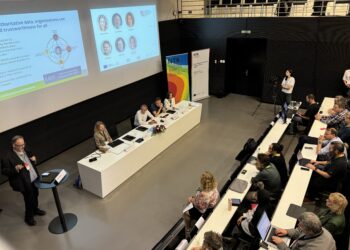Open access (OA) continues to be a high-priority topic in scholarly publishing as OA mandates increase worldwide and deliberation around business models and funding continues. But OA is just one element of the broader subject of open research (OR), which includes open access, open data, open source (including code, architecture, trained models, process, parameters, etc.), open peer review, and open methodologies — strategies and procedures that make all elements of the research process openly accessible, transparent, and reusable.
As scholarly publishing starts to come to grips with changes around OR, artificial intelligence (AI) and generative AI (GAI) have crashed onto the scene, with the launch of GAI products such as ChatGPT and Google Bard boosting applications and usage. AI is growing fast and has shifted from the R&D and prototype stage to the full commercial application stage — and from analytic AI that examines existing content to generative AI that generates new information. As its capabilities develop, AI and GAI should align with and be governed by human goals and values and be compliant with applicable laws.
The Alliance between Open Research and Artificial Intelligence
Separately, both OR and AI are considered disrupters, causes of disorder in the normal continuance of scholarly publishing. But approaching them in a synchronized way can offer more productivity gains and efficiencies than taking them on individually:
- OA allows more connection to content to train more powerful AI (subject to Terms of Use), while open data provides richer and more machine-readable content — not just text but also video, images, code, data, and virtual reality — to push AI toward multimodality. In addition, open source is speeding up AI development, because people and vendors can learn from one another instead of starting from scratch.
- As the OR and intelligent age progresses, from a product and business perspective we will see more requests and needs for AI to boost new AI applications. More demand, more requests, and more use cases for AI will drive AI needs and help build richer and more successful AI products.
- AI can be used to improve the efficiency and productivity of research and publishing to produce and disseminate more and higher-quality OA publications. AI can be used to create more and better OA content, including via generative AI, and to improve the discoverability, distribution, understanding, and application of OA content.
AI and OR: Opportunities and Benefits
AI capabilities are already making an impact on research and content today, though governance and best practice guidance are still catching up. The real benefits and potential opportunities of AI to OR are already significant.
Knowledge Discovery
AI can enhance content discovery, making it easier for researchers to quickly and accurately find answers — not just content — in this era of information overload. How does this work?
- AI can generate more complete and disambiguated metadata to enhance discovery and move search from the traditional keyword-based model to semantic and conversation-based searches.
- AI can also help publishers improve accessibility, to make content available to a broader audience.
- AI as a reader and consumer will become as important a consideration as the human reader and consumer. Publications should consider machines as consumer and provide machine readable and consumable formats.
- AI can create personalized recommendations and news feeds, simultaneously helping researchers find the answers they need and allowing publishers to target specific audiences for specific publications.
- Even better, AI can perform reverse engineering to measure the contribution of each source to the final answers. And publishers can charge based on the contribution. This could be new business model in the future. Many AI researchers are currently working on enabling explainable and transparent AI, but this research will take time.
Improve Workflow
“Is this workflow the right one for our needs?” is a perennial question in our industry — and one that AI can be leveraged to help humans answer. What are some potential uses of AI to improve workflow?
- Publishers can use AI to streamline operations (cutting costs, increasing speed, and growing output) while supporting research integrity efforts.
- AI can also help publishers better understand both authors and readers/users — learning their interests, areas of expertise, and intentions, identifying the right audiences for their content, and optimizing ad placements for improved monetization.
- By using AI to expand, enrich, and link content with worldwide research information, publishers, industry, and funders can better assess research impacts and trends, identify gaps and opportunities, and even predict future outcomes such as pricing, demand, and market trends.
AI and OR: Changes and Challenges
No matter how you approach AI and Open Research, challenges and change are inevitable. Here are some predictions and important factors to consider for scholarly publishing.
Changes
As well as creating new content, AI can help extract more value-added and hidden information from existing content to help knowledge discovery. For both human and machine consumers, more knowledge-based services will evolve to replace the existing service model based on text content. Ultimately, the future of information discovery will see a shift from search and discovery to on-demand creation from AI generated content.
AI will have an impact on metrics and how we measure success in scholarly publishing. With increasingly vast amounts of data and research output, we will need richer and better metrics, beyond the Impact Factor, to assess the value of researchers’ work. AI can be used to mine granular information from publications (such as methodologies and equipment) so that researchers can cite, compare, and measure factors such as replicability, transparency, and data usage.
Finally, while AI can generate content in seconds, humans can take hours or days; we will see more AI-generated content appear, and it will eventually be a majority of the content available. Importantly, human-generated content will continue to be more valuable.
Challenges
As mindsets change, more people will go from resisting AI to embracing it, learning how to leverage it in their day-to-day work. At the same time, because generative AI can be used to create new and innovative works that don’t fit within traditional protocols and regulations, our industry will need to answer new questions and formulate new policies. For example, who owns the copyright on a GAI-generated, but still completely original, article? As AI’s capabilities expand, to what extent should we leverage AI to help us write papers? Should we accept AI as authors? Should we redefine the meaning of contribution?
As we already know, generative AI is trained on existing works, sometimes without permission from the creators or copyright holders. In response to this challenge, governments and regulators around the world, with input from numerous impacted industries like scholarly publishing, are beginning to develop new and stronger governance policies and oversight, including transparency and accuracy requirements, and the protection of human rights. Impacted industries are also taking proactive steps, including creating policies and guidance for employees on acceptable use of GAI, as well as broader, public-facing “principles” statements.
We also know that while GAI has the power, if used responsibly, to boost research quality and collaboration, it also brings challenges to research integrity and accuracy, including the potential increase in plagiarism, image manipulation, and paper mills. In general, fraud involving AI is becoming harder for humans to detect.
In addition, there is a risk that as AI becomes an indispensable part of our work and life, excessive reliance on AI tools may erode the critical and creative thinking skills that give humans a unique advantage.
There is a natural conflict between the principles of transparency that underpin the OR movement and the “black box” nature of existing AI models; for many people, it’s difficult to trust conclusions generated by a process they can neither see nor fully understand. Many AI researchers and providers are currently working on enhancing their models to be more transparent, accurate and their use more conscious of human rights, but this will take time.
On the horizon: Looking ahead
As we have seen with other industry disrupters—for example, the shift from print to digital publishing — the roles of people, the industry, and our jobs will adapt as the technology changes. Publishers will continue to bring new and important research to the world.
A special thank you to Sylvia Izzo Hunter for her editorial assistance on this post. Sylvia is Manager, Product Marketing, Community & Content, at Wiley Partner Solutions; previously she was marketing manager at Inera and community manager at Atypon, following a 20-year career in scholarly journal and ebook publishing.
Discussion
1 Thought on "Approaching Artificial Intelligence and Open Research in Sync: Opportunities and Challenges"
Another great post Hong. Thanks for putting this all together so succinctly.
Agree with almost everything you say, and hope Wiley are doing some “serious” thinking and acting along these lines to flip their business model accordingly.
My sense is many publishers will prefer to resist and find ways to entrench the old business model rather than seriously invest in embracing the opportunities and overcoming the challenges posed by AI. As you imply, it won’t be easy and it certainly will not be cheap, but I think it’s worthwhile, especially since legacy publishers currently own the copyrights to many of the historical research articles, an advantage that they will no longer have once most of research is published OA and the likes of OpenAI can swoop in on it all at no cost. As a matter of fact, Elsevier have put a lot of that data up for sale already, so it’s already available to OpenAI and others who are ahead in terms of technology development if they want it. See: https://www.elsevier.com/about/press-releases/elsevier-introduces-authoritative-scientific-datasets-to-fuel-innovation-and. First-mover advantage will only last so long.
I hope you and your Team have the support you need to work on developing solutions before it’s too late for Wiley. Good luck to you all!




